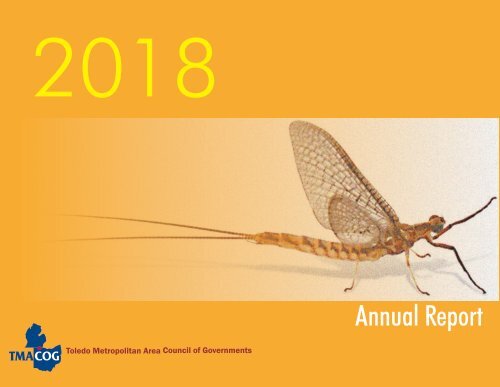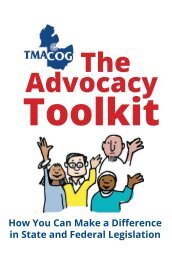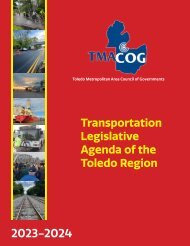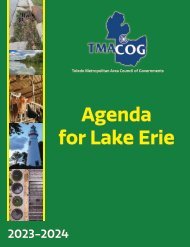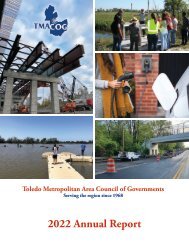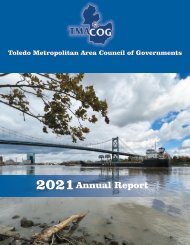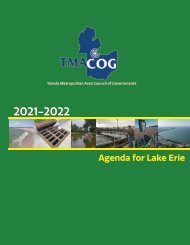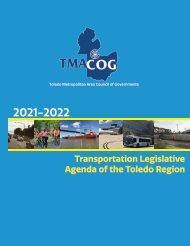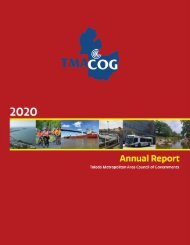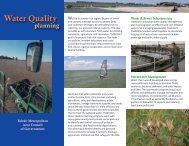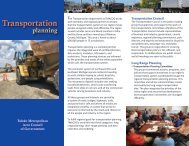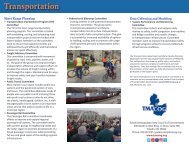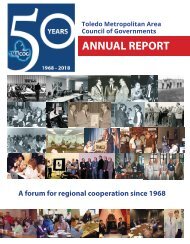TMACOG 2018 Annual Report
Toledo Metropolitan Area Council of Governments 2018 Calendar Year Annual Report
Toledo Metropolitan Area Council of Governments 2018 Calendar Year Annual Report
Create successful ePaper yourself
Turn your PDF publications into a flip-book with our unique Google optimized e-Paper software.
<strong>2018</strong><br />
<strong>Annual</strong> <strong>Report</strong><br />
Toledo Metropolitan Area Council of Governments
Our Vision:<br />
Toledo Metropolitan Area Council of Governments will be the<br />
governmental partner of choice to coordinate regional assets,<br />
opportunities, and challenges.
Table of Contents<br />
<strong>Annual</strong> <strong>Report</strong> Calendar Year <strong>2018</strong><br />
• Letter from the President and Chair..................................................................2<br />
• Lists<br />
• Officers and Executive Committee.................................................................3<br />
• Governmental Members.................................................................................4<br />
• Non-governmental Members.........................................................................5<br />
• Department <strong>Report</strong>s<br />
• Administration Department <strong>Report</strong>...............................................................6<br />
• Transportation Department <strong>Report</strong>................................................................8<br />
• Water Quality Department <strong>Report</strong>...............................................................12<br />
• Organizational Chart........................................................................................17<br />
• Financials..........................................................................................................18<br />
• <strong>TMACOG</strong> Staff...............................................................................................19<br />
• <strong>TMACOG</strong> Contact Information.....................................................................20<br />
In Memoriam<br />
Judge Andy Devine, first Chair of <strong>TMACOG</strong><br />
1921-<strong>2018</strong><br />
1.
A letter from the Chair & President<br />
P<br />
eople only see the wild mayflies dance for a few days of their lives but we know that before they hatch, they have been quietly growing under water and ice<br />
for as long as two years. <strong>TMACOG</strong>’s planning activities can feel like that. Sometimes it seems like things don’t change for a long time, and then all at once<br />
there’s a metamorphosis. Right now, at the end of <strong>2018</strong>, we seem to be in one of those pauses – waiting for state and federal decisions on how we will attack<br />
the problems in Lake Erie, weighing regional transportation needs that far exceed the funding made available by state and federal governments. However,<br />
we’ve been in the planning business for 50 years and counting and we know that our work beneath the surface is essential.<br />
In the last year, the <strong>TMACOG</strong> Water Quality Council and its committees have established the Agenda for Lake Erie, a closely written and well-researched<br />
position paper and legislative blueprint. We expect that this agenda will be one of the agents of change as legislative and regulatory decisions are made. The<br />
Wastewater Committee completed a two-year project mapping sources of nutrients in 19 Ohio counties. This data will be essential as we allocate our resources<br />
to improve water quality. <strong>TMACOG</strong> partnered with concerned farmers to support innovation in best management practices in their fields. These are<br />
foundational projects that will support years of effort.<br />
In 2019 we will be working on the Transportation Legislative Agenda, another critical document. We are also updating the 2045 Transportation Plan. This<br />
long range plan makes big projects possible even when the needed resources are a long way off. The intersection of State Route 25 and I-475 in Perrysburg<br />
was in <strong>TMACOG</strong> plans for many years. That project became the award-winning diverging diamond interchange. The short range transportation projects that<br />
are handled by the Transportation Improvement Program (the TIP) are managed proactively, ensuring that every dollar of our $55 million local investment<br />
from the current $750 million TIP goes to a regional priority project. We are quietly and effectively working toward accomplishments.<br />
Planning for the future also means planning for next generations who will take over environmental stewardship and urban planning. We’re growing this population<br />
with outreach projects including Clear Choices Clean Water which is building a community of volunteers. Gohio Commute is finding and encouraging<br />
people who want to commute with less impact on the environment. The Student Watershed Watch doubled in size in <strong>2018</strong>, teaching a thousand students<br />
how to measure water quality.<br />
One job for the students was to identify the mayfly larva, to recognize that summer army of fliers in their tiny aquatic growing stage. Students learn an<br />
important lesson: that the mayflies, fragile on their own, make up a formidable force when the hatch acts as one.<br />
Doris I. Herringshaw, Ed.D.<br />
<strong>TMACOG</strong> Chair<br />
President of Commissioners, Wood County<br />
Tim W. Brown<br />
President<br />
Toledo Metropolitan Area Council of Governments<br />
2.
Officers & Executive Committee<br />
Executive Committee Officers<br />
Chair: Doris I. Herringshaw - President of Commissioners, Wood County<br />
Vice Chair: Mark W. Stahl - Commisioner of Ottawa County<br />
Leadership Development Committee<br />
Chair: Doris I. Herringshaw - President of Commissioners, Wood County<br />
Vice Chair: Mark W. Stahl - Commisioner of Ottawa County<br />
Councils<br />
Water Quality Council<br />
Chair: Carol A. Contrada - Commissioner, Lucas County<br />
Vice Chair: Jon Eckel - Director of Public Service, City of Perrysburg<br />
Transportation Council<br />
Chair: Keith G. Earley - County Engineer, Lucas County<br />
Vice Chair: James M. Bagdonas - Municipal Administrator, City of Waterville<br />
Communications Committee<br />
Chair: Scott Carpenter - Director of Public Relations, Metroparks Toledo<br />
Vice Chair: Sheri L. Bokros - Vice President, Business Development,<br />
The Mannik & Smith Group<br />
Finance & Audit Committee<br />
Chair: Troy P. Dowling, Administrator - Public Service, City of Toledo<br />
Vice Chair: Charles Hoecherl - Trustee, Township of Monclova<br />
Membership Committee<br />
Chair: Kenneth L. Gilsdorf, Trustee - Township of Lake<br />
Vice Chair: Robert P. Mack, Trustee - Township of Perrysburg<br />
<strong>2018</strong> At - Large Members<br />
Michael A. Aspacher – President of Council, Third Ward, City of Bowling Green<br />
Gordon A. Bowman – Mayor, Village of Pemberville & Chair, <strong>TMACOG</strong><br />
Portage River Basin Council<br />
Lori A. Brodie – Mayor, City of Waterville<br />
Robert P. Mack – Trustee, Township of Perrysburg<br />
Patrick McColley – Deputy Director, ODOT District 2 (ex-officio member)<br />
Al Prieur – Deputy Supervisor, Township of Bedford<br />
Kay E. Reiter – Commissioner, Sandusky County<br />
Angie Ruiz – Council Member, Third Ward, City of Fremont<br />
James M. Sass – Commissioner, Ottawa County<br />
Edward L. Snyder – Trustee, Northwestern Ohio Rails-to-Trails Association Inc.<br />
Sandra L. Spang – Council Member-At-Large, City of Toledo<br />
Craig A. Stough – Mayor, City of Sylvania & Immediate Past <strong>TMACOG</strong> Chair<br />
At the <strong>2018</strong> General Assembly: Tim Brown, <strong>TMACOG</strong> president; Craig Stough, outgoing <strong>TMACOG</strong> chair and mayor of Sylvania; Doris Herringshaw, incoming<br />
<strong>TMACOG</strong> chair and president of Wood County commissioners; Mark Stahl, incoming <strong>TMACOG</strong> vice chair and Ottawa County commissioner.<br />
3.
Governmental Members<br />
Counties<br />
Lucas County<br />
Monroe County<br />
Ottawa County<br />
Sandusky County<br />
Wood County<br />
Cities<br />
City of Bowling Green<br />
City of Clyde<br />
City of Fostoria<br />
City of Fremont<br />
City of Maumee<br />
City of Monroe<br />
City of Napoleon<br />
City of Northwood<br />
City of Oregon<br />
City of Perrysburg<br />
City of Port Clinton<br />
City of Rossford<br />
City of Sylvania<br />
City of Toledo<br />
City of Waterville<br />
Villages<br />
Village of Archbold<br />
Village of Berkey<br />
Village of Bradner<br />
Village of Clay Center<br />
Village of Delta<br />
Village of Elmore<br />
Village of Fayette<br />
Village of Gibsonburg<br />
Village of Green Springs<br />
Village of Haskins<br />
Village of Holland<br />
Village of Hoytville<br />
Village of Lindsey<br />
Village of Luckey<br />
Village of Lyons<br />
Village of Metamora<br />
Village of Millbury<br />
Village of North Baltimore<br />
Village of Oak Harbor<br />
Village of Ottawa Hills<br />
Village of Pemberville<br />
Village of Portage<br />
Village of Put-in-Bay<br />
Village of Risingsun<br />
Village of Swanton<br />
Village of Walbridge<br />
Village of Wayne<br />
Village of Weston<br />
Village of Whitehouse<br />
Townships<br />
Township of Bedford<br />
Township of Erie<br />
Township of Henry<br />
Township of Jackson<br />
Township of Jerusalem<br />
Township of Lake<br />
Township of Middleton<br />
Township of Monclova<br />
Township of Perrysburg<br />
Township of Richfield<br />
Township of Spencer<br />
Township of Springfield<br />
Township of Sylvania<br />
Township of Troy<br />
Township of Washington<br />
Township of Whiteford<br />
Special Districts<br />
Lucas County Metropolitan Housing Authority<br />
Metroparks Toledo<br />
Northwestern Water & Sewer District<br />
Ohio Turnpike & Infrastructure Commission<br />
Port of Monroe<br />
Sylvania Area Joint Recreation District<br />
Toledo Area Regional Transit Authority (TARTA)<br />
Toledo-Lucas County Port Authority<br />
Toledo-Lucas County Public Library<br />
Wood County Park District<br />
Wood County Port Authority<br />
Schools, Colleges & Universities<br />
Bowling Green State University<br />
Lourdes University<br />
The Maritime Academy of Toledo<br />
Monroe County Community College<br />
North Baltimore Local Schools<br />
Northwood Local Schools<br />
Ottawa Hills Local Schools<br />
Owens Community College<br />
Penta Career Center<br />
Rossford Exempted Village Schools<br />
Sylvania Schools<br />
Toledo Public Schools<br />
The University of Toledo<br />
Wood County Educational Service Center<br />
4.
Non-Governmental Members<br />
AAA Northwest Ohio Region/AAA Club Alliance<br />
A.A. Boos & Sons, Inc.<br />
American Rivers<br />
Associated General Contractors of Northwest Ohio<br />
AT&T Ohio<br />
Beckett & Raeder, Inc.<br />
Black Swamp Bird Observatory<br />
Black Swamp Conservancy<br />
BP-Husky Refining, LLC<br />
Civil & Environmental Consultants, Inc.<br />
Columbia Gas of Ohio<br />
ConnecToledo<br />
CT Consultants, Inc.<br />
Jones & Henry Engineers, Ltd.<br />
Jones-Hamilton Company<br />
Mannik & Smith Group, Inc.<br />
Maumee Valley Adventurers, Inc.<br />
Maumee Valley Heritage Corridor<br />
Monroe Bank & Trust<br />
Monroe County Chamber of Commerce<br />
National Electrical Contractors Association<br />
Northwest Ohio Regional Economic Development (NORED)<br />
Northwestern Ohio Rails-to-Trails Association (NORTA)<br />
Ohio Contractors Association<br />
Ohio Farm Bureau<br />
Davey Resource Group<br />
DGL Consulting Engineers, LLC<br />
DLZ Corporation<br />
Eastern Maumee Bay COC<br />
Eastman & Smith, Ltd.<br />
Envirosafe Services of Ohio, Inc.<br />
E.S. Wagner Company<br />
Feller, Finch & Associates, Inc.<br />
FirstEnergy/Toledo Edison<br />
First Federal Bank of the Midwest<br />
Genoa Bank<br />
Great Lakes Community Action Partnership<br />
Henry County Chamber of Commerce<br />
Home Builders Association of Greater Toledo, Inc.<br />
Hull & Associates, Inc.<br />
Huntington Bank<br />
Partners for Clean Streams, Inc.<br />
Perstorp Polyols, Inc.<br />
Poggemeyer Design Group, Inc.<br />
ProMedica<br />
Regional Growth Partnership<br />
Republic Services, Inc.<br />
Rudolph/Libbe Companies, Inc.<br />
Safety Council of Northwest Ohio<br />
Stantec Consulting Services, Inc.<br />
Toledo Refining Company<br />
Toledo Regional Chamber of Commerce<br />
Toledo Trucking Association<br />
Transportation Advocacy Group of Northwest Ohio (TAGNO)<br />
We Are Traffic, LLC<br />
Woolpert, Inc.<br />
Non-governmental members at the summer caucus<br />
and forum with state lawmakers.<br />
5.
Administration<br />
The <strong>TMACOG</strong> administration manages<br />
the full-time staff of 22 with some seasonal<br />
interns and part-timers. Administration is<br />
responsible for all the usual operation of a<br />
small business: human resources issues, all<br />
forms of insurance, physical property, and<br />
paying the bills. As a quasi-governmental<br />
agency the administrative staff is also tasked<br />
with managing grants, following federal<br />
accounting and reporting regulations, and<br />
managing member dues. All practices are<br />
transparent and audited annually by the<br />
state of Ohio.<br />
• October <strong>TMACOG</strong> Tech: Tools and<br />
Rules for Managing Meetings. An<br />
overview of parliamentary procedure, tools<br />
to conduct meetings fairly and in an<br />
orderly manner.<br />
Toledo City Council member,<br />
Sandy Spang, talks <strong>TMACOG</strong> Tech.<br />
Past <strong>TMACOG</strong> chairs at <strong>TMACOG</strong>’s 50th anniversary event:<br />
Standing: Jim Sass, Doris Herringshaw, Craig Stough, and David<br />
Scott. Seated: Mark Pietrykowski, Marge Brown, Andy Devine,<br />
Barbara Sears, and Jimmy Carter.<br />
Projects of <strong>TMACOG</strong> that serve all members<br />
and are not tied directly to a Transportation<br />
or Water Quality Planning project fall<br />
under administration. In <strong>2018</strong> <strong>TMACOG</strong><br />
continued to organize and present the popular<br />
<strong>TMACOG</strong> Tech sessions. These short<br />
programs, free to members, are designed to<br />
build professional expertise in elected officials<br />
and administrators.<br />
Staff and members celebrated <strong>TMACOG</strong>’s<br />
fiftieth anniversary in <strong>2018</strong>. Member<br />
meetings included historical displays and<br />
photos. WBGU donated a production of<br />
a video highlighting <strong>TMACOG</strong>’s<br />
influence in the region, and in April the<br />
current administration hosted an anniversary<br />
party attended by many of <strong>TMACOG</strong>’s<br />
30 past chairs.<br />
• February <strong>TMACOG</strong> Tech: Sexual<br />
Harassment and Bullying in the Work<br />
place. Advice for employers and employees<br />
for establishing a safe and fair workplace.<br />
• April <strong>TMACOG</strong> Tech: Ohio Sunshine<br />
Laws Certification Training. Elected<br />
officials are required to complete this<br />
training (or send a designee) once during<br />
each elected term. The session is also<br />
open to private citizens.<br />
Want to see more photos?<br />
6.
Many long-time <strong>TMACOG</strong> partners recognized the fifieth anniversary with proclamations and resolutions.<br />
Membership remains strong.<br />
In <strong>TMACOG</strong>’s fiftieth year there are 145 governmental and non-governmental members. New or returning members in <strong>2018</strong> are:<br />
• AAA Northwest Ohio Region /AAA Club Aliance<br />
• Columbia Gas of Ohio<br />
• ConnecToledo, Downtown Development Corporation<br />
• Home Builders Association of Greater Toledo, Inc.<br />
• Jackson Township, Wood County<br />
• The Maritime Academy of Toledo<br />
• ProMedica<br />
• We Are Traffic<br />
7.
Transportation Planning<br />
In <strong>2018</strong> <strong>TMACOG</strong> learned that funds for the discretionary portion of the Transportation Improvement Program will<br />
be drastically reduced. By fiscal year 2021-22, the planning area of Lucas and Wood counties in Ohio will see $3 million<br />
less for short range regional transportation plans. This will put the region further behind in critical maintenance, repair,<br />
and construction. This cut adds to already serious shortfalls in funding from state and federal sources. In the fall of <strong>2018</strong><br />
<strong>TMACOG</strong> received 39 applications in a round of Surface Transportation Block Grants requesting a total of about $60<br />
million. There was about $14 million available for appropriation.<br />
State and federal lawmakers have not addressed<br />
the Highway Trust Fund which is<br />
the source of funding for highways, transit,<br />
and more. It is supported by the gas tax<br />
which has not been raised since 1993. To<br />
bring the region’s transportation needs and<br />
priorities to the attention of state and federal<br />
lawmakers, <strong>TMACOG</strong> is updating the<br />
Transportation Legislative Agenda for 2019-<br />
2020.<br />
<strong>TMACOG</strong> staff is engaging transportation<br />
stakeholders to be part of the Toledo Region<br />
Transportation Coalition that updates the<br />
agenda. Published by <strong>TMACOG</strong> every two<br />
years, the agenda represents the consensus of<br />
a diverse coalition that includes local governments,<br />
business groups, economic development<br />
agencies, construction and supply<br />
chain associations, accessibility interests, and<br />
university and health care institutions. See<br />
the current agenda here and look for information<br />
on stakeholder comment opportunities<br />
on www.tmacog.org.<br />
Studies are the Foundation of Plans<br />
With the increasing number of downtown<br />
Toledo residents and more downtown employees<br />
driving, cycling, and walking in<br />
the area, the city of Toledo began a new<br />
downtown transportation study. <strong>TMACOG</strong><br />
provided modeling for the study. Under<br />
consideration are new transit (bus) patterns,<br />
changing some one-way streets to two-way,<br />
and plans to safely incorporate more bicycles<br />
including 100 new bikeshare cycles which are<br />
distributed in 17 stations around downtown.<br />
<strong>TMACOG</strong> funded the ToleGo bike share<br />
project with Transportation Alternatives<br />
funds.<br />
8.<br />
Foundational studies and research accomplished<br />
in <strong>2018</strong> provide the support for<br />
<strong>TMACOG</strong>’s larger policy documents and<br />
long range plans that will be in development<br />
in 2019. Good plans are created with data,<br />
analysis, and public input.
The Intelligent Transportation<br />
System<br />
ITS describes the network of communication<br />
strategies used on roads and highways.<br />
This system is growing increasingly complex.<br />
Only a few years ago the big questions were<br />
how to improve truck driver in-cab communications<br />
and how to remotely update<br />
traffic warning signs. ITS now integrates<br />
mobile devices in and out of vehicles, stationary<br />
sensors, and increasingly complex<br />
signals generated by vehicles themselves.<br />
<strong>TMACOG</strong> staff and members participated<br />
in regional planning meetings in <strong>2018</strong> that<br />
are specifically addressing infrastructure to<br />
support a connected future transportation<br />
system. A new <strong>TMACOG</strong> committee was<br />
formed to prepare for autonomous and<br />
connected vehicles. <strong>TMACOG</strong> partnered<br />
with AAA, TARTA, and the University of<br />
Toledo to form the Autonomous Vehicle<br />
Steering Committee.<br />
A series of studies looked at rail travel for<br />
both freight and passengers. <strong>TMACOG</strong>’s<br />
Passenger Rail Committee and the Public<br />
Transit Committee both contributed information<br />
to an updated Ohio Statewide Rail<br />
Plan. Last updated in 2010, the Ohio rail<br />
plan describes the state’s long-term vision<br />
for rail service and the role of passenger and<br />
freight rail in Ohio’s multimodal transportation<br />
system.<br />
<strong>TMACOG</strong> is participating a study of the<br />
feasibility of restoring passenger rail connections<br />
between Toledo and Detroit. In<br />
partnership with the City of Toledo, the<br />
study will examine possible routes, address<br />
likely capital and operating costs, and estimate<br />
potential ridership.<br />
In a study of where rails and roads intersect,<br />
<strong>TMACOG</strong> is working with the Ohio Rail<br />
Development Commission on a study to<br />
identify bottlenecks and chokepoints caused<br />
by rail traffic in northwest Ohio.<br />
Several other studies will also contribute to<br />
<strong>TMACOG</strong>’s long range and short range<br />
plans. In <strong>2018</strong> <strong>TMACOG</strong> staff completed<br />
the Safety Locations <strong>Report</strong> and approved<br />
safety performance management targets;<br />
updated the Multimodal Needs Assessment<br />
and Congestion Management <strong>Report</strong> in<br />
coordination with regional plans; and reviewed<br />
and monitored pavement condition<br />
and bridge condition data.<br />
Long Range Planning<br />
<strong>TMACOG</strong>’s long range transportation<br />
plan creates a vision for the region’s<br />
transportation system that is based on<br />
regional needs and is fiscally constrained.<br />
By maintaining a vision that goes out<br />
20 years or more, these plans ensure that<br />
ambitious goals can be achieved.<br />
Where We’re Going,<br />
We Won’t Need Traffic<br />
Lights<br />
Connected and autonomous vehicles will change our<br />
transportation infrastructure in some surprising ways.<br />
Here’s some changes that are likely within the next 20<br />
years.<br />
• Fewer traffic signs. When your car knows where it’s going,<br />
it won’t need signs on the highway.<br />
• Traffic lanes could be narrower and medians may be<br />
unnecessary.<br />
• Semi trucks will move in head-to-tail platoons almost like<br />
trains.<br />
• Vehicles could drive a LOT faster on highways.<br />
• We’ll have new drop-off lanes in urban areas where cars will<br />
pause and change passengers.<br />
• Empty parking lots will be put to new uses.<br />
• Disabled people (and other non-drivers) will have the same<br />
transportation options as able-bodied people.<br />
• We’ll see better first mile and last mile connections with<br />
door-to-door transportation.<br />
• Since nearly all traffic crashes are caused by driver error,<br />
we’ll see many fewer injuries. And since crashes cause traffic<br />
congestion, fewer backups.<br />
Get ready for some new terminology<br />
• Vehicle to Vehicle (V2V) technology. Cars and trucks will<br />
emit signals to let other vehicles know speed, position, and<br />
trajectory, and will also receive and interpret signals from<br />
other vehicles.<br />
• Vehicle to Infrastructure (V2I) technology. Cars will<br />
communicate with stationary objects. For example, orange<br />
barrels will have embedded technology to make temporary<br />
work zones safer. Traffic signals will react to emergency<br />
vehicles and to amount of traffic. Your car will know if the<br />
bridge ahead is ice-covered and will drive appropriately.<br />
9.
<strong>TMACOG</strong> began the revision to “On<br />
the Move: 2045 Transportation Plan” in<br />
<strong>2018</strong>. This plan was created in 2015 and is<br />
regularly updated to keep it accurate and<br />
effective. Public meetings, surveys, and<br />
stakeholder input will take place in 2019 to<br />
create Update 2020. The review will look for<br />
changes in local priorities and review fiscal<br />
constraints. The full plan and the schedule<br />
for Update 2020 are posted on the<br />
<strong>TMACOG</strong> website here.<br />
The “On the Move: 2045 Transportation<br />
Plan” is based on eight goals:<br />
1. Safety: Reduce traffic-related fatalities<br />
and serious injuries across all modes.<br />
2. Infrastructure condition: Maintain and<br />
improve the transportation system to a<br />
state of good repair.<br />
3. Congestion reduction: Reduce congestion<br />
on the National Highway System<br />
4. System reliability: Improve the efficiency<br />
of the surface transportation system.<br />
5. Freight movement: Strengthen freight<br />
access to national and international trade<br />
markets to support economic development<br />
6. Environmental sustainability: Protect<br />
and enhance the community and natural<br />
environments.<br />
10.<br />
7. Project delivery: Expedite project<br />
delivery to maximize effective use of<br />
public funds.<br />
8. Personal mobility: Improve the quality,<br />
accessibility, and efficiency of the multimodal<br />
personal transportation system.<br />
Short Range Planning<br />
The Transportation Improvement<br />
Program (the TIP) is the four-year plan of<br />
transportation projects. The TIP committee<br />
reviews and ranks funding requests for<br />
federal assistance in the development and<br />
implementation of transportation projects.<br />
In fiscal year <strong>2018</strong> ( July 1, 2017 - June 30,<br />
<strong>2018</strong>), federal money obligated for transportation<br />
projects in Lucas and Wood<br />
counties was approximately $61.6 million<br />
for 102 projects.<br />
<strong>TMACOG</strong> responded to federal and state<br />
initiatives in <strong>2018</strong> to establish performance<br />
measures to be included in the TIP and in<br />
long range plans. <strong>TMACOG</strong> has begun<br />
to incorporate performance measures and<br />
targets in the areas of roadway and bridge<br />
conditions, safety, transit, travel time reliability,<br />
and air quality.<br />
<strong>TMACOG</strong> Pograms and <strong>Annual</strong> Events<br />
Transportation Summit<br />
• The theme of the March <strong>2018</strong> Transportation Summit was “What’s<br />
it Take to Make it Safe?” with presentations on distracted driving,<br />
impaired driving, and trends in accident rates as well as construction<br />
updates for the region. Check out the Summit photos here.<br />
Specialized transportation<br />
• The Specialized Transportation Program managed by <strong>TMACOG</strong><br />
and TARTA awards grants to be used for transportation services to the<br />
elderly and/or disabled. Regional agencies awarded in <strong>2018</strong> are Anne<br />
Grady Corporation and Bittersweet Farms. Both agencies used the<br />
funds to purchase and maintain handicap accessible vans.<br />
Outreach and Education<br />
• Gohio Commute rewards<br />
commuters who choose to carpool,<br />
take the bus, or ride a bike. The interactive<br />
website gohiocommute.com<br />
matches commuters and tracks mileage.<br />
Ozone Action Season rolled out<br />
a new campaign on billboards, TV,<br />
radio, print ads, at Mud Hens stadium,<br />
and social media. The campaign<br />
shares information about air pollution<br />
and asks people to take steps to<br />
reduce the amount of pollution they generate.<br />
• <strong>TMACOG</strong> published a<br />
new Bicycle Users Map in<br />
May, in time for annual Bike<br />
Month activities. The map<br />
shows how area cyclists use<br />
paths, streets, and bike lanes<br />
to commute. Download a<br />
printed map here. An online<br />
GIS map here shows<br />
traffic volumes and speed<br />
limits to help cyclists plan<br />
their route.
Innovative Intersections<br />
Safer, more efficient transportation is the result of clever design and construction in our region.<br />
Roundabouts, the diverging diamond, and the SPUI (single point urban interchange), have made a difference.<br />
Roundabouts Transform Problem Area<br />
See the series of intersections created by the<br />
City of Toledo out of the “thousand islands”<br />
area adjacent to Overland Industrial Park.<br />
This massive project changed a dangerous<br />
and chaotic tangle of industrial and commuter<br />
traffic into a smoothly flowing system. The<br />
area also includes an adjacent multi-use path<br />
that protects cyclists and pedestrians and<br />
helps them move safely and easily through<br />
the area. New green space and civic art make<br />
the entire area welcoming.<br />
Diverging Diamond<br />
Driving on the “wrong” side of the road and<br />
putting pedestrians and cyclists between<br />
lanes on the bridge are solutions that make<br />
this intersection work with minimal signaling.<br />
Well-designed berms and barriers direct<br />
the traffic to keep vehicles from veering into<br />
wrong lanes.<br />
One of the reasons that the intersection at<br />
State Route 25 in Perrysburg has received<br />
awards is because the new intersection made<br />
use of an existing bridge, saving time and<br />
money. The $8.5 million project was partially<br />
funded with $3.3 million of Congestion<br />
Mitigation and Air Quality (CMAQ) funds<br />
awarded and scheduled by <strong>TMACOG</strong>. This<br />
project was managed by ODOT.<br />
Click to see how it works.<br />
2014 2017<br />
SPUI<br />
Using a single traffic signal location, the<br />
SPUI (single point urban intersection) at<br />
Central Avenue (US 20) and I-475/US 23)<br />
has improved a previously tricky and dangerous<br />
intersection. Before the improvement,<br />
some drivers who wanted to exit to US 20<br />
had to merge, cross, and exit the highway in<br />
a congested corridor. Now local traffic moves<br />
easily and highway exits are safer.<br />
2014<br />
2017<br />
11.
Water Quality Planning<br />
A Focus on Lake Erie<br />
Issues affecting the health of Lake Erie are<br />
large, complex, and interrelated. <strong>TMACOG</strong><br />
staff, members, and partners are getting<br />
their arms around the issues with a broad<br />
reach. Projects as diverse as professional<br />
training for water and wastewater treatment<br />
plant operators, an inventory of unsewered<br />
areas, and a project documenting a year<br />
in agriculture all came back to the health<br />
of Lake Erie. Stormwater projects, which<br />
emphasize treating rainwater and snowmelt<br />
where they fall, are also related to keeping<br />
waterborne pollutants out of area tributaries<br />
and Lake Erie. The year <strong>2018</strong> included scientific<br />
research, public policy, and practical<br />
efforts.<br />
Water Quality Council<br />
The WQC is the policy-making committee<br />
of the Water Quality Planning department.<br />
This diverse group includes the chair and<br />
vice chair of the five WQ committees, and<br />
elected officials, operators of water and<br />
wastewater plants, agriculture interests, representatives<br />
of park districts, private citizens,<br />
and environmental consultants and engineers.<br />
In <strong>2018</strong> they continued to learn from<br />
researchers working on the problems of<br />
Lake Erie. Working carefully and in consultation<br />
with committee members and experts,<br />
the group also commented on public<br />
policy and crafted policy documents.<br />
A major topic of discussion all year was the<br />
concept of “impairment” for Lake Erie. The<br />
term has legal and administrative implications<br />
that are not completely agreed upon by<br />
regulatory agencies and local governments.<br />
A WQC meeting on May 14 addressed an<br />
audience of 100 on the topic: “Lake Erie<br />
Impaired: What’s Next for the Western Lake<br />
Erie Basin.” Speakers at that meeting included<br />
Craig Butler, director of Ohio EPA;<br />
Steve Arndt, state of Ohio Representative;<br />
and Ken Kilbert, professor at the University<br />
of Toledo College of Law and expert on environmental law. The<br />
expertise of the speakers is typical of the in-depth study that the<br />
WQC undertook. Other WQC meetings were held at water treatment<br />
plants, habitat restoration sites, and a park with new kayak<br />
and canoe facilities.<br />
Experts educate <strong>TMACOG</strong> members at a meeting of the Water Quality Council.<br />
12.
Creating consensus policy and agreeing on<br />
next steps has been the work of dozens of<br />
people from the broad membership of the<br />
WQC. The policy group provided comments<br />
to state legislators regarding the Clean Lake<br />
Erie 2020 Plan in late June. Kari Gerwin,<br />
director of Water Quality Planning, also<br />
gave a statement to the Ohio Soil and Water<br />
www.tmacog.org/AFLE<br />
Conservation Commission regarding the<br />
Toledo Metropolitan Area Council of Governments<br />
Ohio Department of Agriculture’s proposed<br />
300 Martin Luther King, Jr. Drive, Suite 300 | Toledo, OH 43604<br />
Phone: 419.241.9155 | Fax: 419.241.9116<br />
“distressed watersheds” www.tmacog.org<br />
designation.<br />
What the WQC hopes will be the most<br />
influential work of the group this year is<br />
the Agenda for Lake Erie. In development<br />
for more than 18 months, the document<br />
includes seven policy briefs that represent<br />
the priorities and position of <strong>TMACOG</strong>’s<br />
diverse members:<br />
• Legal Tools for Addressing Harmful<br />
Algal Blooms<br />
• Moving Forward with Lake Erie’s<br />
Impairment Designation<br />
• Municipal Stormwater Management<br />
Programs<br />
• Restoration and Protection of Natural<br />
Drainage Systems<br />
• Public Water Supply and Wastewater<br />
Treatment<br />
• Home Sewage Treatment Systems<br />
• Agriculture<br />
Agenda for<br />
Lake Erie<br />
2019 - 2020<br />
Toledo Metropolitan Area Council of Governments<br />
Water Quality Council<br />
This legislative agenda will be used to engage<br />
state legislators and local decision-makers<br />
on policies and practices that will improve<br />
Lake Erie. The Agenda for Lake Erie was<br />
approved by the <strong>TMACOG</strong> Board of<br />
Trustees in December. Click above to read<br />
the entire Agenda with policy briefs.<br />
Watersheds<br />
<strong>TMACOG</strong> members work in several watersheds<br />
that drain to Lake Erie: the Toussaint,<br />
Portage, Ottawa, Swan Creek, and Maumee<br />
river watersheds. In <strong>2018</strong>, <strong>TMACOG</strong><br />
partnered with Soil and Water Conservation<br />
Districts from Ottawa and Wood counties<br />
on a Great Lakes Restoration Initiative grant<br />
that supports a range of agricultural best<br />
management practices in the Portage and<br />
Toussaint River watersheds: water control structures, cover crops, and<br />
variable rate fertilizer application. The grant helps farmers purchase<br />
and install structures, pay for seed, and hire specialized fertilizer<br />
applicators.<br />
Growing out the grant program, <strong>TMACOG</strong> staff worked with some<br />
of the participating farmers and others in the region to document a<br />
growing year with a video and series of print articles. Scientists have<br />
determined that agriculture is the source of more than 80 percent of<br />
the phosphorus that reaches Lake Erie and contributes to harmful<br />
algal blooms. This series shows how area farmers make choices during<br />
the year to both grow a profitable crop and protect the<br />
environment that is their livelihood. Click on<br />
the photo to launch a short preview video.<br />
The Portage River Basin Council moved forward<br />
on a Portage River Water Trail, working<br />
with the Ohio Department of Natural<br />
Resources and a partnership of local interests.<br />
A water trail designates public canoe/kayak<br />
access points along a waterway. In 2019, the<br />
stakeholders and the cities, townships, and<br />
counties involved will be working to secure<br />
grants for improved access and signage.<br />
13.
Public Water Supply and Wastewater<br />
A two-year <strong>TMACOG</strong> project to identify<br />
sewered and unsewered areas in 19 Ohio<br />
counties was completed and published in<br />
<strong>2018</strong>. The Nutrient Source Inventory for<br />
Septic Systems and Package Plants was completed<br />
in June. The project used aerial photos,<br />
health department records, permits, and other<br />
resources to put together the first comprehensive<br />
map and data collection of this nature in<br />
the region. Using the information collected,<br />
planners can identify areas where people are<br />
relying on septic systems for wastewater treatment<br />
and make decisions about where to invest<br />
resources for the most impact in reducing<br />
bacteria and phosphorus loading into waterways.<br />
Rural areas and small communities with<br />
aging infrastructure face challenges to treating<br />
waste; they are often far from a treatment<br />
plant and need financial assistance to invest in<br />
modern wastewater treatment infrastructure.<br />
A significant revision of <strong>TMACOG</strong>’s<br />
Areawide Water Quality Management Plan<br />
(208 Plan) documented sewer separation<br />
projects throughout the five-county 208 Plan<br />
region and modified some Facility Planning<br />
Areas. Critical sewage areas are being reduced<br />
through expanded sewer connections to water<br />
treatment facilities.<br />
In related projects, staff have also begun work<br />
on three planning projects funded by the<br />
Ohio EPA. Staff are assisting the Ottawa<br />
County Health Department to map locations<br />
of home sewage treatment systems in that<br />
14.<br />
Members of <strong>TMACOG</strong>’s Public Water Supply and Wastewater committees<br />
toured the City of Toledo Collins Park Water Treatment Plant as part of<br />
on-going research.<br />
county. The goal is to develop better records<br />
for both government and the general public.<br />
<strong>TMACOG</strong> is also coordinating with partners<br />
to update, maintain, and develop nonpoint<br />
source implementation strategies. The<br />
goal is to identify projects aimed at improving<br />
water quality in the western Lake Erie<br />
basin. Outreach and education efforts will<br />
focus on environmental science for students<br />
in grades 5-12 as well as everyday steps<br />
the general public can take to reduce water<br />
pollution.<br />
<strong>TMACOG</strong> coordinates professional development training for water<br />
and wastewater operators.
Stormwater<br />
A grant-funded project that installed seven<br />
green stormwater management practices<br />
in three central Toledo neighborhoods was<br />
completed in <strong>2018</strong>. The two-year project<br />
was funded by a $250,000 grant from<br />
the Great Lakes Restoration Initiative.<br />
<strong>TMACOG</strong> provided project management<br />
and coordinated stakeholders. Maintenance<br />
of the bioswales and rain gardens will be<br />
taken over by the City of Toledo and area<br />
residents who have been involved in the<br />
planning and construction of the gardens as<br />
part of a neighborhood improvement plan.<br />
Outreach and Public Information<br />
<strong>TMACOG</strong> manages programs that help educate<br />
students and the general public about<br />
steps that individuals and households can<br />
take to protect water supplies.<br />
The Student Watershed Watch, now beginning<br />
its 30th year, grew exponentially<br />
in <strong>2018</strong>. Nearly 1000 students took part in<br />
water collection and analysis during the field<br />
work part of the program in October. This is<br />
an increase of nearly 80 percent over previous<br />
years. Teachers have said that the Student<br />
Watershed Watch is a good match for<br />
their curriculum.<br />
<strong>TMACOG</strong> staff has used this green stormwater site to continue<br />
educational opportunities with the students at Pickett<br />
Elementary School.<br />
Check out teacher Lara Fish on<br />
<strong>TMACOG</strong>Tube<br />
A newer outreach program, Clear Choices,<br />
Clean Water, creates a community of people<br />
who are taking steps to prevent water pollution.<br />
More than 600 people have volunteered<br />
to pick up after<br />
their pets, reduce<br />
fertilizer use, adopt<br />
a storm drain, or<br />
use native plants in<br />
their gardens. The<br />
CCCW network<br />
allows volunteers<br />
to see who else<br />
in their area is<br />
participating and<br />
facilitates group<br />
activities.<br />
PICK UP<br />
PET POO<br />
It All<br />
Piles Up<br />
M A K E A DIFF E R E N C E!<br />
Take a Poo Pledge at<br />
ToledoLakeErie.ClearChoicesCleanWater.org<br />
Field work is an important part of the annual<br />
Student Watershed Watch.<br />
<strong>TMACOG</strong> Director of Water Quality Planning<br />
Kari Gerwin and Joe Cappel of the Toledo-Lucas<br />
County Port Authority were among the speakers on<br />
a WQC tour of the Maumee River.<br />
15.
It All Adds Up: Measuring Water Quality Interest<br />
<strong>TMACOG</strong> members were engaged in<br />
attending a total of 34 meetings of the seven<br />
main Water Quality council and committees<br />
in <strong>2018</strong>. Photos of meetings<br />
Nearly 1000 students supported by more than 30 teachers participated in water quality testing for the Student<br />
Watershed Watch, nearly double the numbers in 2017. Teachers value how the program fits into their curriculum.<br />
Grants administered by <strong>TMACOG</strong> have<br />
helped farmers plant 4,665 acres of cover<br />
crops and manage drainage water on 300<br />
acres. Learn more about how farmers use<br />
best management practices in a short video.<br />
Professional operators and engineers of<br />
water and wastewater plants earned up to<br />
13.75 professional certification hours each<br />
at <strong>TMACOG</strong> workshops and meetings in<br />
<strong>2018</strong>.<br />
Bonus Mayfly Factoid<br />
Mayflies live from a few hours to 2 days after they hatch out of their freshwater<br />
homes and take flight.<br />
There are more than 3,000 species of mayfly (order Ephemeroptera), grouped<br />
into more than 400 genera in 42 families. This order is part of an ancient group of<br />
insects termed the Palaeoptera, which also contains dragonflies and damselflies.<br />
The outreach program Clear Choices, Clean Water is creating a community<br />
of people who are taking steps to prevent water pollution. More than<br />
600 people have volunteered and logged in their activities at the Toledo<br />
Lake Erie CCCW website.<br />
Bonus Mayfly<br />
Factoid<br />
The size of annual mayfly<br />
hatch is related to the<br />
general health of Lake<br />
Erie, but not directly correlated<br />
to the algae bloom<br />
or to microsystin levels.<br />
Mayflies are vulnerable to<br />
silt and pollution so a big<br />
hatch is a positive sign.<br />
16.<br />
In the 9 years that <strong>TMACOG</strong> has administered Clean Ohio funds<br />
through the Natural Resources Assistance Council, 1,992 acres have been<br />
preserved in Lucas County and made available for public access.
<strong>TMACOG</strong> Organizational Structure<br />
17.
Financials<br />
Fiscal Year <strong>2018</strong> | July 1, 2017 - June 30, <strong>2018</strong><br />
Member Dues and Assessments<br />
$781,946<br />
Project Contributions &<br />
Other Local Funds<br />
$238,558<br />
Federal Program Support<br />
$1,381,790<br />
State Program Support<br />
$216,768<br />
Total Revenues:<br />
$2,619,062<br />
Revenue Actual <strong>2018</strong> Expense Actual <strong>2018</strong><br />
Direct Wages & Fringe Benefits<br />
$987,196<br />
Administrative Wages & Fringe Benefits<br />
$653,282<br />
Direct Program Costs<br />
$579,176<br />
Administrative Overhead Costs<br />
$299,467<br />
Contingencies & Reserves<br />
$99,942<br />
Total Expenditures<br />
$2,619,062<br />
Transportation<br />
$1,450,897<br />
Environment<br />
$941,915<br />
Member Services<br />
$126,308<br />
Contingencies & Reserves<br />
$99,942<br />
Total<br />
$2,619,062<br />
Funding Distribution by Activity<br />
Federal Transportation<br />
$1,146,954<br />
Federal Water Quality<br />
$234,837<br />
State Transportation<br />
$132,902<br />
State Water Quality<br />
$83,866<br />
Local Transportation<br />
$171,041<br />
Local Water Quality<br />
$623,212<br />
Local Member Services<br />
$226,250<br />
Funding Distribution by Source<br />
Total<br />
$2,619,062<br />
18.
We are <strong>TMACOG</strong><br />
Administration<br />
Tim W. Brown<br />
President<br />
Bill Best<br />
Vice President<br />
of Finance & Administration<br />
Jennifer Allen<br />
Executive Secretary<br />
Nate Reiter<br />
Accountant<br />
Gilda Mitchell<br />
Director of Membership &<br />
Outreach<br />
Donna Seeber<br />
Secretary | Receptionist<br />
Ann Nair<br />
Administrative Assistant<br />
Transportation<br />
David Gedeon, AICP<br />
Vice President<br />
of Transportation<br />
Lance Dasher, AICP<br />
Transportation Planner<br />
Jodi Cole<br />
Transportation Secretary<br />
Roger Streiffert<br />
Transportation Planner<br />
Lisa Householder<br />
Transportation Planner<br />
Database Analyst<br />
Marc Vondeylen<br />
Transportation Technician III<br />
Dana Doubler<br />
Transportation Planner<br />
Mike Fuller<br />
Transportation Planner<br />
Austin Mack<br />
Public Administration<br />
Associate<br />
Water Quality<br />
Communications<br />
Kari Gerwin<br />
Director<br />
of Water Quality Planning<br />
Kris Barnswell<br />
Water Quality Planner<br />
Sara Guiher<br />
Water Quality Planner<br />
Joy Minarcin<br />
Water Quality<br />
Administrative Assistant<br />
Tatiana Burkett<br />
Water Quality Associate<br />
Mary Pat McCarthy<br />
Marketing & Public<br />
Information Manager<br />
Mike Tippett<br />
Digital Communications<br />
Manager<br />
19.
Join <strong>TMACOG</strong> on our social media platforms.<br />
Like us: https://www.facebook.com/<br />
<strong>TMACOG</strong><br />
Follow: @<strong>TMACOG</strong>, @TimBrown<strong>TMACOG</strong>, @Gohio Commute <strong>TMACOG</strong><br />
Blog and discussion: tmacogblog.blogspot.com<br />
Offices:<br />
Toledo Metropolitan Area Council of Governments<br />
300 Martin Luther King, Jr. Drive, Suite 300<br />
Toledo, OH 43604<br />
Mail delivery:<br />
Toledo Metropolitan Area Council of Governments<br />
PO Box 9508<br />
Toledo, OH 43697-9508<br />
Phone:<br />
419.241.9155<br />
Fax: 419.241.9116<br />
Watch us: https://www.youtube.com/user/TmacogTube<br />
Follow us: https://www.instagram.com/tmacog_photos/<br />
20.<br />
www.tmacog.org<br />
Persons requesting special accommodations due to limited English proficiency, disabilities<br />
of language, mobility, or other handicap are invited to contact <strong>TMACOG</strong> Accessibility<br />
Coordinator Jennifer Allen (allen@tmacog.org or 419.241.9155, ext. 1107).
Mission Statement<br />
To improve quality of life in the region, <strong>TMACOG</strong> will:<br />
-Promote a positive identity for the region.<br />
-Enhance awareness of the region’s assets and opportunities.<br />
-Be an impartial broker of regional disputes and challenges.<br />
-Provide stakeholders a voice in regional decision-making.<br />
-Support opportunities for regional stakeholder networking.
www.tmacog.org<br />
Toledo Metropolitan Area Council of Governments


